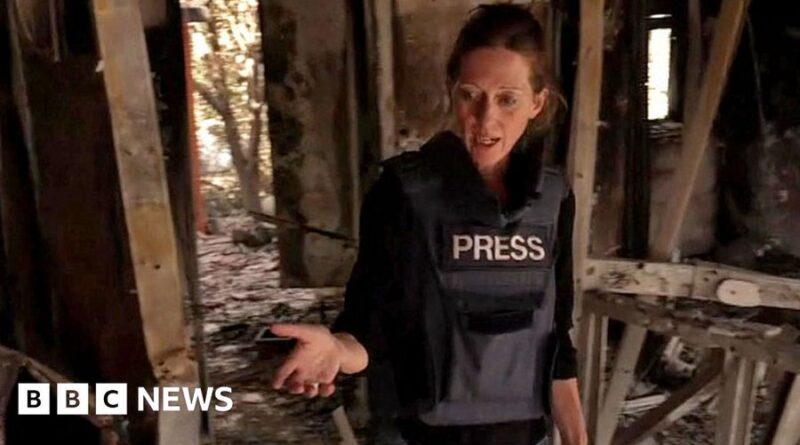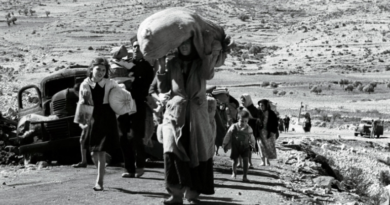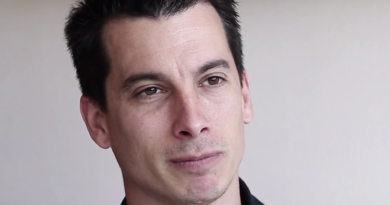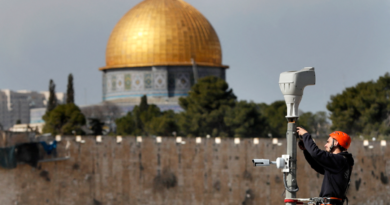What they don't tell us about October 7
It is poor journalistic practice that the media continues to repeat with such credulity the Israeli military's account of that day.
JONATHAN COOK
The BBC's Lucy Williamson was taken once again last week to see the terrible destruction at a kibbutz community on the outskirts of Gaza attacked on October 7. As we have been shown so many times, Israeli houses were riddled by automatic fire, both inside and outside. Sections of concrete walls had holes or had collapsed completely. And parts of the buildings still standing were deeply charred. It seemed like a small snapshot of the current horrors in Gaza.
There is a possible reason for those similarities, one that the BBC refuses to report, despite mounting evidence from various sources, including the Israeli media. Instead, the BBC resolutely clings to a narrative crafted for them, and the rest of the Western media, by the Israeli military: that Hamas alone caused all this destruction.
The mere repetition of that narrative without any warning has already reached the level of journalistic malpractice. And yet that is precisely what the BBC does night after night.
A simple look at the remains of the various kibbutz communities that were attacked that day should raise questions in the mind of any good reporter. Were the Palestinian militants in a position to inflict physical damage of such magnitude with the type of light weapons they carried?
And if not, who else but Israel was in a position to wreak such havoc?
Another question that good journalists should ask themselves is this: What was the objective of such damage? What did the Palestinian militants hope to achieve with this?
The implicit answer the media is giving is also the answer the Israeli military wants the Western public to hear: that Hamas engaged in an orgy of gratuitous murder and savagery because... well, let's say the silent part out loud: because Palestinians are inherently savages.
With that implicit narrative, Western politicians have license to cheer on Israel as it murders a Palestinian child in Gaza every few minutes. After all, savages only understand the language of savagery.
Brutal tango
For this reason alone, any journalist who wishes to avoid collusion with the genocide unfolding in Gaza should be increasingly cautious about simply repeating the Israeli military's claims about what happened on October 7. They certainly should not credulously regurgitate the latest propaganda from the IDF press office, as the BBC is evidently doing.
What we know from a growing body of evidence gathered from the Israeli media and from Israeli eyewitnesses - carefully laid out, for example, in this report by Max Blumenthal - is that the Israeli army was completely surprised by the events of that day. Heavy artillery, including tanks and attack helicopters, was used to confront Hamas. That appears to have been a direct decision regarding the military bases that Hamas had overrun.
Israel has a long-standing policy of trying to prevent Israeli soldiers from being taken captive – mainly, due to the high price that Israeli society insists on paying to ensure that soldiers are returned. For decades, the call “Hannibal procedure” of the army has ordered Israeli troops to kill their comrades rather than allow themselves to be taken captive. For the same reason, Hamas spends a great deal of energy trying to find innovative ways to seize soldiers.
The two parties are essentially engaged in a brutal tango in which each understands the other's dance steps.
Given the situation of Hamas, which de facto runs the Israeli-controlled Gaza concentration camp, its resistance strategies are limited. Capturing Israeli soldiers maximizes their influence. You can exchange them for the release of many of the thousands of Palestinian political prisoners imprisoned in Israel, in violation of international law. Furthermore, in negotiations, Hamas often hopes to achieve a relaxation of the 16-year-old Israeli siege of Gaza.
To avoid this scenario, Israeli commanders would have called in attack helicopters against the military bases overrun by Hamas on October 7. The helicopters apparently fired indiscriminately, despite the risk it posed to the Israeli soldiers at the base who were still alive. Israel's was a scorched earth policy to prevent Hamas from achieving its objectives. That may explain, in part, the large proportion of Israeli soldiers among the 1.300 dead that day.
Charred bodies
But what about the situation in kibbutz communities? By the time the army arrived and moved into position, Hamas was well entrenched. He had taken the inhabitants hostage inside their own homes. Israeli eyewitness testimonies and media reports suggest that Hamas was almost certainly attempting to negotiate safe passage back to Gaza, using Israeli civilians as human shields. Civilians were the only ticket out for Hamas fighters, and could later become bargaining chips for the release of Palestinian prisoners.
The evidence, coming from Israeli media reports and eyewitnesses, as well as a wealth of visual clues from the crime scene itself, tells a much more complex story than that presented each night on the BBC.
Did the Israeli army fire on Hamas-controlled civilian homes in the same way it had fired on its own military bases, and with the same disregard for the safety of the Israelis inside? Was the objective in each case to prevent at all costs Hamas from taking hostages whose release would demand a very high price from Israel?
Kibbutz Be'eri has been a favorite destination for BBC reporters eager to illustrate the barbarity of Hamas. It's where Lucy Williamson headed again last week. And yet none of her reporting highlighted comments made to the Israeli newspaper Haaretz by Tuval Escapa, the kibbutz's security coordinator. He said that Israeli military commanders had ordered “bombing the houses against their occupants to eliminate the terrorists along with the hostages.”.
This agrees with the testimony of Yasmin Porat, who sought refuge in Be'eri from the nearby Nova music festival. He told Israel Radio that once the Israeli special forces arrived: “They eliminated everyone, including the hostages, because there was very, very intense crossfire.”
Are the images of charred bodies presented by Williamson, accompanied by a warning about their graphic and disturbing nature, irrefutable proof that Hamas behaved like monsters, bent on the most twisted kind of revenge? Or are these blackened remains evidence that Israeli civilians and Hamas fighters burned side by side after being caught in flames caused by Israeli shelling of homes?
Israel will not accept an independent investigation, so a definitive answer will never be obtained. But that does not exempt the media from their professional and moral duty to be cautious.
“Hamas as savages”
Consider for a moment the stark contrast between the Western media's treatment of the events of October 7 and the attack on the parking lot of Al-Ahli Baptist Hospital in northern Gaza on October 17. , in which hundreds of Palestinians died.
In the case of Al-Ahli, the media was all too willing to dismiss all evidence that the hospital had been hit by an Israeli attack as soon as Israel refuted the claim. Instead, journalists rushed to amplify Israeli counter-accusation that a Palestinian rocket had landed on the hospital. Most media outlets moved forward after concluding that “the truth may never be clear,” or even less credibly, that Palestinian militants were the most likely culprits.
In telling contrast, the Western media has been unwilling to raise a single question about what happened on October 7. They have enthusiastically attributed all the horrors of that day to Hamas. They have ignored the reality of the utter chaos that reigned for many hours and the possibility of poor, desperate and morally dubious decision-making by the Israeli military.
In fact, the media has gone much further. By advancing the “Hamas as savages” narrative, they have promoted obvious fictions, such as the story that “Hamas beheaded 40 babies.” That fake news was even briefly taken up by US President Joe Biden, before its officials will discreetly remove it.
Likewise, it remains a popular trope among Western commentators that “Hamas committed rape,” although once again the allegation lacks evidence so far.
We must be clear. If Israel had serious evidence for any of these claims, it would be aggressively promoting them. Instead, he's doing the next best thing: letting the innuendo gently sink into the audience's subconscious, settling there like a prejudice that can't be interrogated.
There is no doubt that Hamas committed war crimes on October 7, especially by using civilians as human shields. But that type of crime is one we are familiar with, one “ordinary” enough that the Israeli military has also been regularly documented carrying it out. The practice of Israeli soldiers using Palestinians as human shields goes by various names, such as the “neighbor procedure” and “early warning procedure.”
Worse atrocities may also have occurred, especially given the unexpected magnitude of Hamas' success in its exit from Gaza. A large number of Palestinians escaped from the enclave, some of them undoubtedly armed civilians with no connection to the operation. In such circumstances, it would be surprising if there were no examples of the atrocities that make the headlines.
The question is whether these atrocities were planned and systematic, as Israel claims and Western media repeat, or examples of rogue actions by individuals or groups. In the latter case, Israel would not be in a position to judge. Israel's own history is littered with examples of such crimes, including the documented case of an Israeli army unit that in 1949 took a Bedouin girl captive and repeatedly gang-raped her.
Of course, savagery would not be an exclusive trait of Hamas. Following the October 7 attack, videos have emerged of systematic abuses against any captured Hamas fighter, dead or alive. The images show how they are beaten and tortured in public for the gratification of spectators, when it is evident that there is not even the intention of gathering information. Others show the desecrated and mutilated bodies of Hamas fighters.
In this case, no one can claim moral supremacy.
What the media's uncritical promotion of the Israeli narrative of “Hamas as savages” has achieved is something sinister and all too familiar from the West's long colonial history. It has been used to demonize an entire people, presenting them as barbarians or as protectors and facilitators of barbarism.
Israel is using the “savages” narrative as a weapon to justify its escalating campaign of atrocities in Gaza. That is why it is so important that journalists not be fooled. Too much is at stake.
Hamas committed war crimes on October 7 on a scale unprecedented for any Palestinian group. But so far there is little more than the Israeli narrative to suggest that there was unprecedented depravity in Hamas's actions. Certainly, from what we know, it is difficult to see that anything Hamas did that day was worse or more savage than what Israel has been doing daily in Gaza for weeks.
And Israel's actions - from bombing Palestinian families to depriving them of food and water - have the blessing of all major Western politicians.
Jonathan Cook is a British journalist. He was based in Nazareth (Israel) for 20 years. He has worked for various international media in the United Kingdom and the Middle East. In 2011 he received the Martha Gellhorn Special Journalism Award. He is the author of three books on the Israeli-Palestinian conflict, the latest of which: “Disappearing Palestine: Israel's Experiments in Human Despair.”









